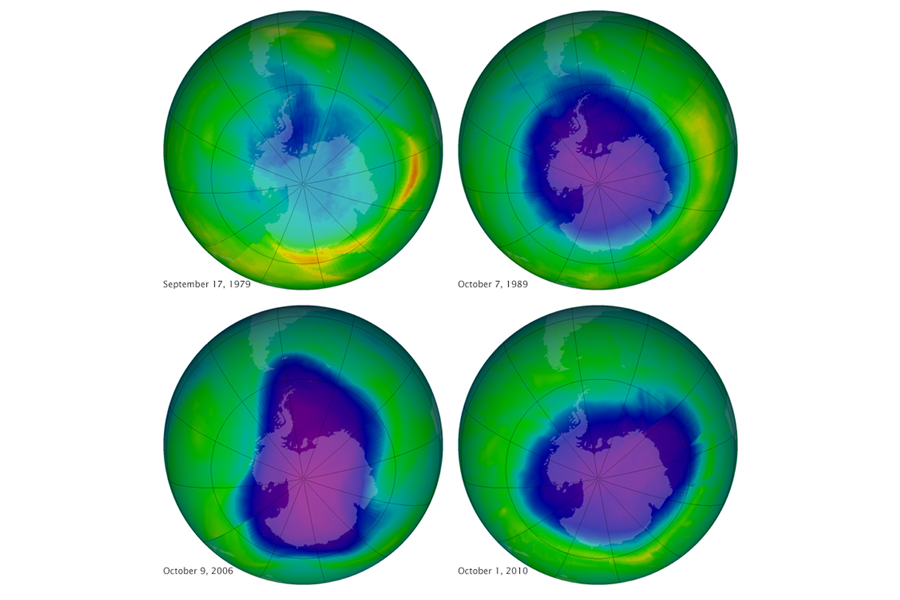Earth's ozone layer: Scientists hail first hints of recovery
Loading...
High in Earth's stratosphere, a protective shield of naturally occurring ozone is showing the first signs of recovery, with full recovery expected over much of the planet by midcentury, including the Arctic. Antarctica should catch up a few years later.
That's the assessment some 300 scientists have offered to countries who are party to the 1987 Montreal Protocol and related agreements – the latest in a series of quadrennial reports on the state of the planet's stratospheric ozone.
The protocol bans the production of chlorine- and bromine-based gases such as chlorofluorocarbons (CFCs) and halons, once widely used for tasks ranging from refrigeration and launching deodorant from spray cans to fire suppression. Overall, about 100 chemicals are covered under the protocol.
Once these gases reach the atmosphere, they persist for decades to be lofted into the stratosphere, where they break up ozone molecules.
These molecules – made of of three oxygen atoms – absorb the most biologically damaging form of ultraviolet radiation that reaches Earth from the sun.
The protocol's goal is to restore stratospheric ozone concentrations to 1980 levels by around 2050, following a steep decline between 1960 and the early 1990s at latitudes spanning the globe from Stockholm to the Southern Ocean. Stratospheric-ozone concentrations bottomed out over Antarctica around 2000 in a feature that became known as the continent's ozone hole.
Although overall ozone levels had dropped 3 to 4 percent by the time the brakes on ozone-depleting chemicals took hold, concentrations of these chemicals could have risen 10 times by 2050, triggering substantial further decline.
Now, mid-latitude ozone concentrations are expected to reach 1980 levels between 2040 and 2060.
"For the first time we are starting to see hints of an increase of ozone, in particular in the upper stratosphere," says Paul Newman, chief scientist for atmospheric science at NASA's Goddard Space Flight Center in Greenbelt, Md.
Between 2000 and 2013, ozone concentrations at an altitude of about 26 miles increased 5 percent. The statistically significant increase, about 4 percent per decade, falls within expectations scientists had based on models of the atmosphere and its chemistry, says Dr. Newman, one of four researchers who chair the scientific panel that produced the assessment.
The assessment, known as the "Scientific Assessment of Zone Depletion: 2014," attributes about half of the increase to the shrinking concentrations of ozone-depleting substances in the atmosphere. The other half is due to the buildup of carbon dioxide (CO2), from burning fossil fuel and from land-use changes. This buildup has in effect trapped heat in the troposphere that otherwise might have reached the stratosphere. Meanwhile, the heat absorbed and re-radiated by CO2 in the less dense, drier stratosphere tends to escape to space.
Because the chemical reactions that destroy ozone depend on temperature, the cooler the stratosphere becomes, the less ozone is destroyed.
No statistically significant trend toward a recovery is seen yet when ozone is measured along an imaginary column rising through the entire atmosphere, although declines in this measure bottomed out around 2000 and concentrations appear to have stabilized.
The one region where stratospheric ozone recovery is unlikely is the tropics, Newman cautions. There, stratospheric ozone concentrations "are projected to remain low over the rest of the century," he says, in effect representing a permanent depletion, although it, too, is small compared with 1980 levels.
Still, "for the tropical countries, that's a bit of a surprise for them," Newman acknowledges.
In addition to its effect on the ozone layer, the Montreal Protocol has "a huge side benefit" in slowing the pace of global warming, says David Doniger, who heads the climate and clean-air program at the Natural Resources Defense Council office in Washington.
The gases the Montreal Protocol has banned also are extremely potent greenhouse gases. The effect of getting rid of chlorofluorocarbons in slowing the pace of warming is about five times larger than the effect of a fully implemented 1997 Kyoto Protocol would have been, he says.
The protocol "has been enormously successful," he says.
Still, more work needs to be done.
One area involves the carbon tetrachloride, perhaps the fourth most potent ozone depleter. It's declining, but at a much slower pace than should be the case.
"That means there has to be some emissions out there that we don't know about," Newman says, even though countries deny emitting carbon tetrachloride. The fugitive emissions appear to be concentrated in the northern hemisphere.
Tracking down the sources represent "a really big challenge," he says.
Another challenge involves hydrofluorocarbons, or HFCs. These represent a second-generation replacement for CFCs. HFCs are benign from an ozone standpoint. But they are potent greenhouse gases.
If the use of HFCs continues to increase, it will erode the climate benefits the Montreal Protocol already has delivered, Newman and Mr. Doniger explain.
The protocol's success could be accelerated by destroying banned chemicals that exist in obsolete equipment, eliminating production of HCFCs, the first generation replacement for CFCs, destroying HCFCs already in use, eliminating carbon tetrachloride emissions, and eliminate emissions of methyl bromide, recovery of stratospheric ozone could come up to 11 years sooner than currently projected, the assessment estimates. The assessment was released Sept. 10.





